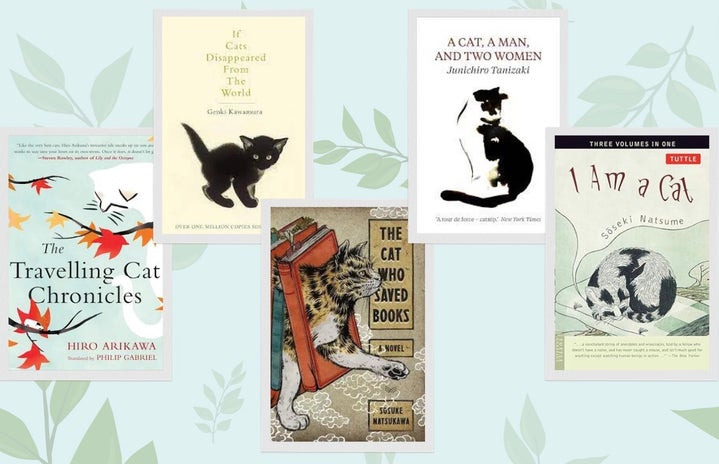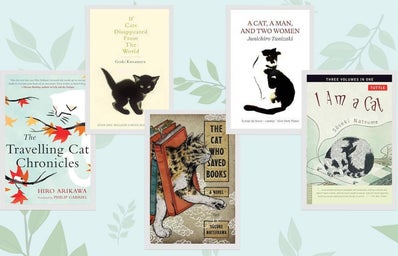If you were to look back at the literary fiction novels written by Japanese authors, there is a prevalent usage of cats. Whether cats are used as symbolism or a character in the novel, cats appear in many well-known authors’ writings. On Goodreads, a reviewer I follow said that her recent, favorite niche genre was Japanese literary fiction about cats. This isn’t the first time I noticed that there were many books featuring cats on the cover, but it’s the first time I realized they were mostly by Japanese authors. I thought the felines’ appearances couldn’t all be a coincidence, so I delved into the works of Japanese writers. Many of whom have added cats to their stories, one way or another, and found other readers who have noticed the pattern and contributed their thoughts to the matter as well.
Cats, or neko, have been a consistent presence in Japanese literature from the beginning – no, literally. The world’s first novel, The Tale of Genji by Murasaki Shikibu, was written in 11th-century Japan and this is around when it is thought the cat was first introduced in the country. The novel gives interesting insight into what the culture surrounding cats was like in the court of Kyoto and gives information on the “anthropological origins of the nekotsuki (“feline possession”) superstition in ancient Japan.” This novel, ultimately, was the start of the cat’s presence in literature and inspired many Japanese authors to include the feline in their writing.
However, in 1905, about 800 years after The Tale of Genji, Natsume Sōseki published his acclaimed novel, I Am A Cat. The novel rose to fame after originally being written as a short story. After students encouraged Sōseki to continue writing the story, he wrote a full novel. Sōseki had the story told as a social commentary from the observations of the feline, who observes the life of a Meiji period household. Sōseki encouraged other authors to criticize social problems and detail life in Japan through different lenses like a cat. This novel was also the start of cats becoming the central figure in the stories, as many writers published stories involving animals throughout the 1900s and on.
Known as the second most famous cat in twentieth-century Japanese literature, after Sōseki’s, Aoneko (The Blue Cat) was a 1923 poetry collection by Hagiwara Sakutarō. The collection includes 55 poems that only repeat the word “cat” a few times throughout, with it being mentioned in the title of two poems and the title of the collection. Sakutarō wrote a short story 12 years later called Nekomachi – sanbunshifū na shōsetsu/roman (Cat Town – A Fantasy in the Manner of a Prose Poem) that has a village become possessed by cat spirits at the end of the text. In 1936, A Cat, a Man, and Two Women by Jun’ichirō Tanizaki was published about a newly estranged couple’s shared cat that they both don’t want to part with, and how they navigate the companionship they’re losing with each other, that the cat fills. Similarly, the 2001 novel The Guest Cat by Takashi Hiraide, the cat in both stories gives a semblance of meaning to the human couple’s lives. Both cats end up filling a missing piece in each of the human’s lives, such as motherhood or companionship, and give the humans emotional fulfillment.
Along with Sōseki’s, I Am A Cat, Sōsuke Natsukawa published The Cat Who Saved Books in 2017 that used a talking cat to say things about society that people may not be as aware of. Both Sōseki’s and Natsukawa’s cats are satirical and wisecracking that “assume a guiding role to humans that encourage self-improvement and self-introspection.” I would say this is similar to Hiro Arikawa’s 2012 novel The Travelling Cat Chronicles. The cat in this novel also presents the negative aspects of human nature in a comical way, but with more sensitivity than Sōseki’s and Natsukawa’s. Novels like 2012’s If Cats Disappeared From The World by Genki Kawamura, for example, use the appearance of cats to contribute to the story differently but still in a symbolic way. Kawamura uses cats in his story to convey the meaning of accepting death, or questioning what would happen if significant things were to disappear from the world. The novel delves into the idea that things that we own, end up owning us and when given the choice on the brink of death, what will the man sacrifice to extend his life? In the end, the man accepts his fate to die because he couldn’t bear having cats disappear. His house cat and his emotional connection to it showed him how important animals are to humans. Using the loss of cats to teach the character the lesson instead of another animal shows me and the reader how highly cats are treated and seen in Japan. Haruki Murakami’s The Wind-Up Bird Chronicle, Kafka on the Shore, and A Wild Sheep Chase are other examples of this pattern. Cats appear in Murakami’s novels as mysterious characters that don’t act as companions to the human characters but to set the adventure into motion.
The cat fulfills the emotional and physical companionship that the human character needs, which I would say is a trend in all the novels I have mentioned thus far. With the theme of loneliness and not feeling understood, the cat in many of the stories is there as a spirit guide of sorts for the human, tying into how Japanese culture views cats.
Japanese writers use the motif of cats for different types of symbolism or roles in their writing, but the feline seems to be mostly a positive element in the stories or plays an important role. This may be because, in Japanese culture specifically, cats are thought to be positive figures that bring good luck or fortune. For example, Japan has a famous legend cited as maneki-neko (beckoning cat) that stemmed from a story during the Edo period. It’s said that a priest’s cat beckoned a lord and his servants to safety from a storm inside the temple with a waving gesture. Since then, maneki-neko statues have been placed by visitors to the temple for good luck. Despite this, cats are also portrayed negatively in Japanese mythology tales and paintings. In Japanese folklore, there are kaibyō which are “strange cat” or known as supernatural cats, that are sometimes depicted as gruesome creatures. Another Japanese folklore tells the story of the kasha described as cat-demons from hell that feasts on corpses. Starting as normal house cats, they would turn into demons once they smelled the scent of dead bodies. Many negative depictions of cats seem to be found in folklore and shown through art, instead of the literary fiction novels that include cat symbolism and characters. Writers may depict more positive features of cats because they are drawing from house cats and cats they have interacted with for inspiration. That is to say, the negative features of cats displayed in Japanese art are supernatural.
Over the course of hundreds of years, the cat has served as a multifaceted symbol of companionship and guidance to humans in Japanese literature. From their portrayal of talking and social commenters to supernatural creatures, cats have left their mark on the literary landscape of Japan. Through the works of authors like Natsume Sōseki, Haruki Murakami, Genki Kawamura, and countless others, cats have helped readers understand the intricate and emotional relationship between humans and animals. Their enduring presence and relevance in Japanese literature, paintings, statues, mythology, and other examples of art shows the deep history that Japanese culture has with animals.


